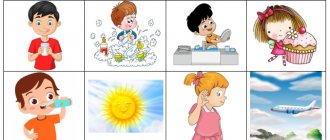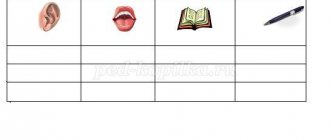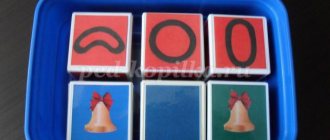Speech therapy lesson summary Topic: “Proposal. Word".
Speech therapy lesson summary Topic. Offer. Word.
Objectives: to consolidate the concepts: “oral and written speech”, “word”, “sentence”, “text”. Develop skills in language analysis and synthesis: dividing text into sentences, sentences into words and composing sentences from words; develop the articulatory apparatus, thinking, coordination of speech with movement, graphomotor skills; to form the duration, smoothness, and strength of voluntary speech breathing. To clarify children’s ideas about the structure of the human body and the purpose of individual parts of the body, to consolidate orientation in space. Develop the ability to listen to yourself and others; instill personal responsibility for doing work. Equipment: baby dragon toy, envelope with written tasks for children, computer, subject and subject pictures.
PROGRESS OF THE LESSON I. Organizational moment Repeat: SA-sa-sa-here comes the wasp. So-so-so - Sonya has a wheel. Os-os-os - Sanya has a dog. Su-su-su - we saw the forest in the forest. II. Articulation gymnastics and breathing exercises. - Guys, today we will do gymnastics for our tongue so that it pronounces sounds correctly. Place mirrors on your desk in front of you. 1. Delicious jam. 2. Needle. 3. Spatula. 4. Punish the naughty tongue. 5. Calyx. Breathing exercise - “Sultans”.
III. Working on the topic. - Guys, the Dragon sent us a letter! And in the envelope there is a letter with assignments. - Tell me, what is speech needed for? (To communicate, talk.) - What kind of speech is there? (Oral and written.) - How do we use oral language? (We hear and pronounce oral speech.) - What kind of written or oral speech is the letter that the Dragon wrote? (In written speech.) - Yes, if not for written speech, would the Dragon be able to communicate with us? (No, I couldn’t.) - To find out what is written or printed, you need to learn to read. Look at the pictures. Who in the pictures uses spoken language and who uses written language?
? Make a word from letters. M, I, R K, o, t - If you rearrange the letters, what new word will you get?
Making sentences based on the picture:
— Guys, look at the pictures and make sentences for them. Leaves fall. It rains often. Birds fly south. People sunbathe on the beach. The children went to school. - Tell me, which of the sentences you have compiled is superfluous? (People sunbathe on the beach.)
- Why? (All other sentences are about autumn, and “People sunbathing on the beach” are about summer.) Drawing up graphic diagrams of sentences.
— Guys, what sentences have you made just now? (Text.) - Why do you think so? (The sentences are united by a common theme - “Autumn.”) Give the text a title. (Autumn.) - What does the text consist of? (The text consists of sentences.) - What does a sentence consist of? (The sentence consists of words.) - The first word in the sentence is written with what letter? (Capital letter.) - How is one sentence separated from another in oral speech? (Pause - stop.) - How is one sentence separated from another in written speech? (A period, a question mark or an exclamation mark.) - Are the words in the sentence written together or separately? (Apart.)
- Let's remember how you can write a sentence without knowing the letters. Each sentence can be written down and designated using a diagram. This makes it easier to determine how many words are in a sentence and how many sentences we have said. The beginning of a sentence is shown by a line protruding above the strip to the left, and the end of the sentence is shown by a dot to the right of the strip.
- Guys, the Dragon has prepared another task for you! Make graphic diagrams of these sentences. - Let's check who correctly compiled the graphical diagrams of the sentences.
VI. Physical exercise Drakosha. (presentation)
VII. Determining the boundaries of sentences in the text. - Guys, let's do one more task! Read the text. Determine how many sentences it contains. Mark the beginning and end of each sentence.
In autumn there is silence in the forest, only leaves rustle under your feet, suddenly a pine branch cracks, the squirrels are starting a game.
VI I. Identification of body parts in Buratina. - Today we will find out what parts of the body a person has, why a person needs them. Knowing the structure of your body means knowing yourself.
— Guys, what part of a person’s body is the most “smart”? (Head). Everyone should have a very smart head.
— What other parts of the human body can you name and show?
There are nails on our fingers, On our hands there are wrists and elbows. Crown, shoulders, forehead and chest And don’t forget the shoulder blades. Hips, heels, two feet, lower leg and ankle. There are knees and a back, but there is only one. On our head we have two ears and two lobes. Eyebrows, cheekbones, and temples, And eyes that are so close. Cheeks, nose and two nostrils, Lips, teeth - look! Chin under lip. This is such a person.
- Call it in one word: head, back, nose, mouth - what is that? (Body parts). - The body has arms and legs.
- Guys, tell me the parts of the hand /shoulder, elbow, palm, fingers, nails/.
-What parts of the leg do you know? /thigh, knee, lower leg, foot, fingers, nails, sole, heels/.
- Oh, what animals don’t have is a face.
- Do you know what other body parts domestic animals do not have, but humans do? /palm, fingers, nails, elbows, arms/.
- Show your right hand, stamp your left foot, turn your head to the right.
? Formation of plural nouns. Ball game: "One - many."
- And now we’ll play the game “One is Many”, I name one object, and you name many. Ear - ears, neck -, eye -, hair -, head -, forehead -, mouth -, nose -, cheek -, finger -, elbow -, eyebrow -….
? Agreement of a noun with a numeral. Game "Think and answer". Let's help Drakosha and Pinocchio - How many eyes do two children have? /two children have four eyes/ - How many ears do three boys have? /those boys have six ears/ - How many fingers are on your left hand? / there are five fingers on the left hand / - How many noses do three girls have? /three girls have three noses/
? Formation of nouns using diminutive suffixes and using the suffix “ISCH”.
not a nose - but ... /nosish/, but the other has /nose/. not a mouth - but ... /mouth/, and the other has /mouth/. arms, legs, forehead, eyes, hair)
? Use of antonyms. Game: “Say the opposite” sad face - /cheerful/ dark hair - /blond/ long hair - /short/ straight hair - /curly/ big nose - /small/ fat -/thin/ tall- /short/ ? Polysemy of words. — Guys, there are words that sound the same, but have different meanings. The nose is on an airplane, on a ship, on a teapot; Handle - by the door, by the bag, fountain pen; The peephole is in the door, near the potatoes; The neck is at the bottle, at the child; The back is at the chair; Brushes – paint brush, grape brush; Tongue - near the shoe, cake; Legs - near the chair, near the mushroom.
VIII. Development of non-speech processes.
Draw the other half of the person in cells. XI. Lesson summary
Article:
Goal: to develop skills in composing sentences of three or more words.
Tasks:
Educational: teach children to correctly form sentences of three or more words; teach how to distribute proposals; teach how to make sentences using a model; learn how to make your own sentences.
Developmental: skills of grammatical design of sentences and their distribution by adding definitions; develop attention and logical thinking.
Educational: develop skills of organized behavior.
Progress of the lesson:
I Organizational moment.
Articulation gymnastics (Logomer. Set of exercises.)
II Subject message.
— We worked with sentences that consisted of only two words. But a sentence can have three, four, five or more words. Today we will learn how to make sentences of three or more words.
III Study of the topic.
1. “Making three-word sentences based on plot pictures”.
Logomer. Image constructor.
- Look carefully at the picture. (Slide No. 7)
- Who is this? (Girl). What is she doing? (is reading). Let's make a sentence - The girl is reading.
- How many words are in our sentence? (Two) Name the first word: who? - girl - the word is a living object. Name the second word: what is the girl doing? – reads – the second word-word-action.
— What is the girl reading? (Book, newspaper).
Girl reading a book (newspaper)
- What word was added to the sentence? Book (newspaper). How many words are there in the sentence? (Three). Let's outline our proposal.
The following pictures are displayed next. (Slide No. 1) The work is carried out in a similar way.
2. “Making three-word sentences based on two object pictures”.
- Look carefully at the pictures. (Slide No. 8) We see two subject pictures: a boy and a fish).
- Let's try to make a sentence by matching the picture with a word that denotes an action:
The boy catches fish.
— Let’s draw up a diagram of our proposal.
The following pictures are displayed next. (Slide No. 9) The work is carried out in a similar way.
3. “Make three-word sentences with each child”.
Each child is given one story picture and is asked to independently compose a three-word sentence based on it.
4. Physical education minute:
Logomer. A set of exercises for the development of motor skills.
5. “Complicating proposals. Making sentences from four words with adding a definition" .
- Now let's complicate these sentences. (Slide No. 10) For example: The bunny is gnawing on a carrot. Carrots (cabbage,...) what? (Delicious) or: What kind of bunny? Fluffy (small,...), etc..
— Let’s draw up a diagram of our proposal.
The following pictures are displayed next. (Slide No. 11) The work is carried out in a similar way.
6. Exercise “Assemble a sentence from words .
- And now I will tell you the words, and you listen to them carefully and collect sentences from them.
Example: Ball, Tanya, catch, big. – Tanya catches a big ball.
- Sweater, mom, knit, beautiful. (Mom knitted a beautiful sweater)
- Fish, fishermen, catch, big. (The fishermen caught a big fish)
- The book, Katya, is interesting to read. (Katya is reading an interesting book)
- Dragonfly, Rita, see, it’s big. (Rita saw a big dragonfly)
— Bun, Vova, buy it, delicious. (Vova bought a delicious bun)
- Children draw with pencils, colored ones. (Children draw with colored pencils)
— Tree, storm, broken, old. (The storm broke the old tree).
IV. Result:
- You did great today! We did very well.
- What new did you learn? What did you like most?
Working with deformed sentences. Editing, grammatical formatting of sentences
Methodological goal: Using ICT as a way to optimize the process of correcting oral and written speech.
Target:
development of coherent speech in speech therapy classes using ICT.
Tasks:
Corrective:
- develop the ability to find and correct speech (logical) errors in sentences;
- develop the ability to make sentences based on a plot picture using supporting questions;
- develop the ability to compose sentences, observing the correct word order;
- teach children to use sentences of various syntactic structures in speech;
- learn to compose sentences with homogeneous members;
— improve the grammatical structure of students’ speech;
— clarify and enrich vocabulary on the topic “Spring”;
Educational:
- develop the ability to correctly express your thoughts;
- develop intonation expressiveness of speech and clear sound pronunciation;
— develop the ability to formulate answers to questions;
- develop speech motor skills and visual perception;
- develop higher mental processes: attention, memory, logical thinking, spatio-temporal ideas;
Educational:
- cultivate a desire to actively work in class;
- develop self-control and adequate self-esteem.
Propaedeutic work:
— teach tongue twisters about spring with students;
— train children in editing deformed sentences.
In my opinion, the set goal and objectives of the speech therapy session were achieved. The students completed the expected tasks.
During the lesson, I emphasized exercise and selected tasks to consolidate work with deformed sentences.
I believe that it is impossible to imagine a modern occupation without the use of information and communication technologies. In my opinion, ICT improves the quality and effectiveness of the educational and correctional process. In this regard, I determined for my work the feasibility of using ICT in speech therapy classes, as a way to optimize the process of correcting written and oral speech. I believe that the use of a variety of non-traditional methods and techniques in correctional work prevents children from becoming tired, supports cognitive activity, and increases the effectiveness of speech therapy work in general. (The introduction of computer technologies today is a new stage in the educational process, therefore I actively include the use of ICT in my practice in the process). Experience shows that the use of PCs in speech therapy classes allows one to monitor the degree of assimilation of the material presented at the final stage of consolidating the acquired knowledge. In addition, the program helps develop memory and attention, which are necessary for children to be successful in elementary school.





